Home> Announcements> The JPO Quick Reads> The JPO Quick Reads September-December 2020
Main content starts here.
The JPO Quick Reads September-December 2020
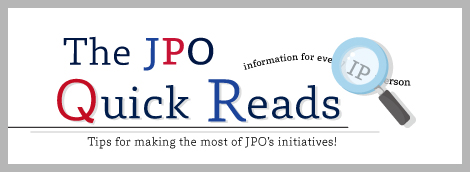
Archives
JPO’s Contribution to the new IPC Subclass G16Y for IoT-related technologies (22 Dec. 2020)
Did you know a new international patent classification (IPC) G16Y has been adopted in January 2020 for Internet of Things (IoT)-related technologies?
Although the applied fields of IoT-related technologies are ever-expanding, access to patent information in such fields had been limited due to the lack of relevant patent classification. Hence in 2016, the JPO established our own patent classification for IoT-related technologies. Based on this experience, we put forward a proposal in international fora on a new classification and contributed to the establishment of IPC subclass G16Y. This new subclass allows examiners and users alike to search prior art for IoT-related technologies in a comprehensive manner.
Why don't you all try using the new classification?
Take a look:
JPO's examination of IoT-related technologies (15 Dec. 2020)
Let me introduce the JPO's initiative on examinations of Internet of Things (IoT)-related technologies.
Just as artificial intelligence (AI) technologies are evolving rapidly amid the Fourth Industrial Revolution, so are IoT-related technologies. We demonstrated our users how we apply the current examination guidelines to IoT-related technologies. Furthermore, we made available to the pubic examination case examples for a better understanding. We encourage you to take advantage of those materials.
We remain committed to proper granting of patent rights for AI and IoT-related technologies!
Take a look:
- Examination Guidelines pertinent to IoT related technologies
- Examination Handbook for Patent and Utility Model in Japan(PDF:2,089KB)
Patent Examination Case Examples on AI-related Technologies (8 Dec. 2020)
The JPO has compiled examination case examples on Artificial Intelligence (AI)-related technologies ahead of other IP offices to deliver information on the points to improve predictability.
The number of patent applications for AI-related inventions is on the sharp rise worldwide, but users may feel they are not well informed about the key to the successful prosecution. This is why we have composed and published 15 AI-related patent examination case examples for users in various technical fields.
We hope this will give you a clear understanding on our examination practices responding to the recent development, in particular, in terms of the description requirement and inventive step.
Take a look:
The 30th Anniversary of the Implementation of Electronic Filing System (1 Dec. 2020)
Did you know, 30 years ago today, the JPO launched the world’s first electronic patent filing system?
On December 1, 2020, we mark the 30th anniversary of the implementation of the e-filing system in Japan. The system realized the digitalization of patent application information, resulting in the creation of a searchable and viewable online database of various patent information. It also paved the way for easy access to dossier from anywhere. Today, patent e-filing rate with us accounts for about 99%!
Currently, e-filing systems have become the norm around the world!
JPO report on AI-related applications (24 Nov. 2020)
The JPO conducts research and delivers information on current trends of AI-related patent applications.
With the development of Artificial Intelligence (AI) -related technologies, patent applications in such fields are growing sharply. Our research on AI-related patent applications, including its analytical data on technical classifications, offices of filing and so forth, aims to provide a snapshot of the technological trends in AI-related inventions, among others, its application fields.
We hope to contribute by shedding light on AI boom through the analysis of patent filing trends!
Take a look:
US-JP Collaborative Search Pilot Program (17 Nov. 2020)
The JPO and the USPTO pursue Collaborative Search Pilot Program (CSP), providing speedy and timely initial examination results with no extra charge.
Under the US-JP CSP, the JPO and the USPTO examiners conduct their own prior art searches for respective patent applications filed in both countries. Then, after exchanging search results and opinions with each other, the two offices independently send their first office actions (FAs) to the applicant in a concurrent manner. Sharing the examiners’ opinions early in the examination process leads to higher possibility of the same or consistent examination results and to less time and efforts for responding to different FAs by respective offices. As a result, applicants are more likely to acquire more robust and stable patent rights.
The third phase of this program has just started on November 1, 2020. What would you say to experiencing the benefits?
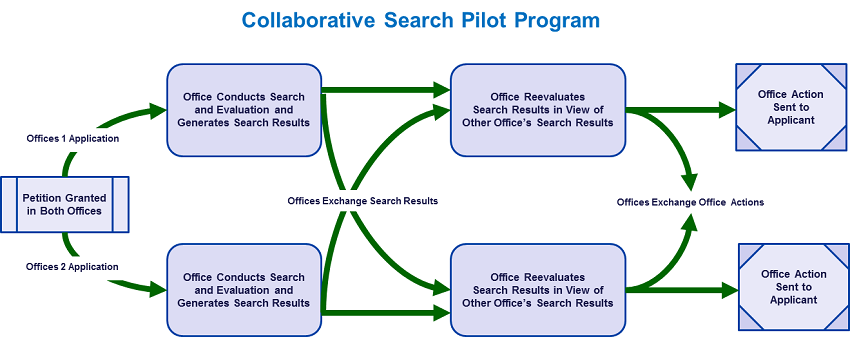
Figure: Workflow process under the US-JP CSP
For more information, go to:
Accelerated Examination under PCT-PPH (10 Nov. 2020)
The JPO assists you to build global patent portfolio smoothly using PCT work products.
You can make use of positive opinions in the PCT international search report (ISR) for PPH request (PCT-PPH). For instance, accelerated examinations can be requested at other IP offices when at least one claim is determined patentable in the ISR provided by the JPO. Currently, we implement the PCT-PPH with 37 IP offices based on our ISRs. For conducting international search, we accept PCT applications filed in English, which means you can do without Japanese translation.
Let the JPO facilitate the prosecution of your patent applications worldwide through this scheme.
- Patent Prosecution Highway using PCT international work products PPH Portal (PCT-PPH)
- Patent Cooperation Treaty Yearly Review - 2020 page 89(External Link)(PDF)
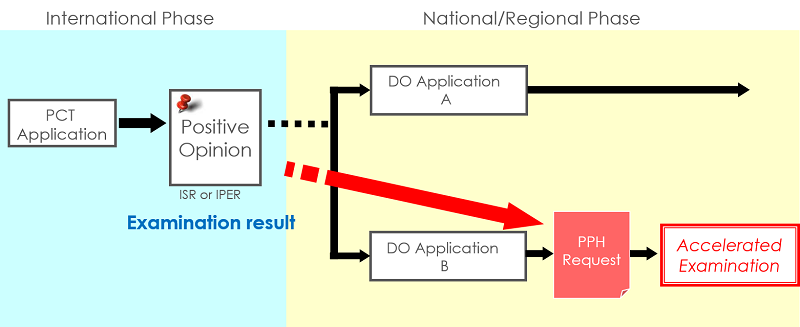
Figure: Outline of the PCT-PPH
English Search Reports at the JPO (27 Oct. 2020)
The JPO establishes search and examination results in English in respect of PCT international applications received by other IP offices.
In the capacity as a competent International Searching Authority for foreign IP offices including USPTO and ASEAN IP offices, we carry out international search in English for PCT international applications filed with those offices. We perform international search with high timeliness performance (deadline compliance rates 99.8%) at relatively reasonable search fees (JPY 156,000 for English ISR as of October 2020).
No need to worry about Japanese translations to obtain the results from the JPO!
For more information, go to:
- The JPO as International Searching Authority (ISA) and International Preliminary Examining Authority (IPEA)
- Patent Cooperation Treaty Yearly Review - 2020 page 84-85 (PDF)(External Link)
Patent Prosecution Highway: PPH (20 Oct. 2020)
Did you know the PPH network has expanded globally through the JPO initiative?
The world’s first PPH, advocated by the JPO in cooperation with the USPTO, was launched in 2006, and the PPH scheme has spread to as many as 54 IP Offices as of January 2020. The JPO has been implementing the PPH with 44 IP offices, including those from major emerging economies; representing the largest network in the world.
Under the PPH framework, an application determined to be patentable by the office of earlier examination is allowed to undergo accelerated examination at the office of later examination. The PPH is expected to increase a grant rate and reduce filing costs.
Why not utilize PPH for building your global IP portfolio?
For more information, go to
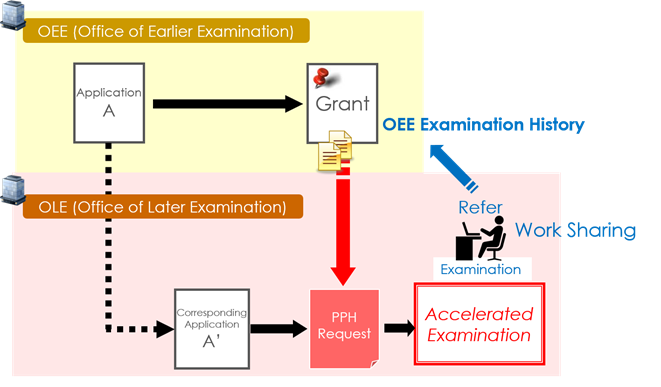
Figure 1: Outline of the PPH
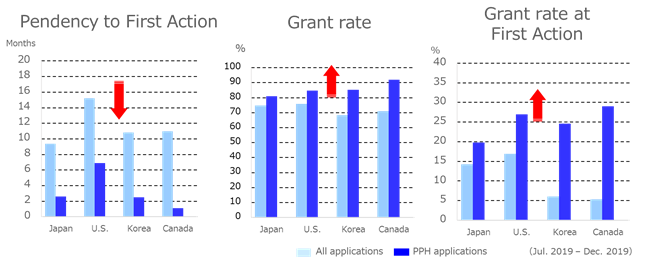
Figure 2: Effect of the PPH
User Satisfaction Surveys on Patent Examination Quality (14 Oct. 2020)
Our patent examination quality is appreciated by users!
The JPO conducts user satisfaction surveys on patent examination quality covering users at home and abroad every year. The 2020 survey shows more than 95 % of our users responded they were satisfied, somewhat satisfied, or neutral as for our overall patent examination quality. Based on the users’ needs expressed in the surveys, we set priorities for further improvements.
We continue to enhance our services in response to your feedback.
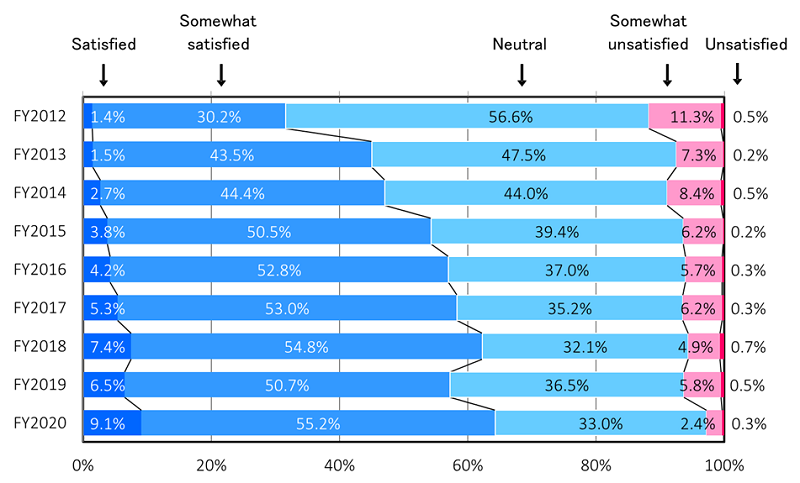
Figure: Satisfaction level with overall patent examination quality of national application
Quality Management Initiatives at the JPO (6 Oct. 2020)
The JPO is further focusing on “granting quality patents.”
In its pursuit for excellence, we are committed to uniform operational practices and consistency in examinations through a variety of initiatives. Such initiatives include consultations among examiners (about 40,000 cases in FY2019) and quality checks of all drafted notices, such as Notice of Reasons for Refusal, by supervising directors. Sample checks are also conducted, prior to the dispatch of notices, to judge the validity of prior art searches and reasoning by quality management officers. Furthermore, we improve these quality control initiatives by reflecting the evaluations and recommendations by external experts.
Inviting external experts for quality management is such a unique thing among IP offices.
For more information, go to:
Accelerated Examination (29 Sep. 2020)
The JPO offers fast-tracked examination at no extra charge.
Applications filed with both the JPO and at least one foreign IP Office are eligible for the accelerated examination system. The average FA pendency under the accelerated system is 2.5 months in 2019, which is much shorter than 9.5 months under the regular system.
Sometimes we all need examination results as soon as possible, don't we?
For more information, go to
Speedy Examinations at the JPO (15 Sep. 2020)
Did you know the pendency of patent examinations at the JPO is much shorter than before?
The first action pendency (FA pendency) is about 9.5 months.
In 2009, the total pendency required three years on average. The JPO achieved to speed up patent examinations, and now, it is 14 months on average including international applications.
Don't you think it's gone pretty fast?
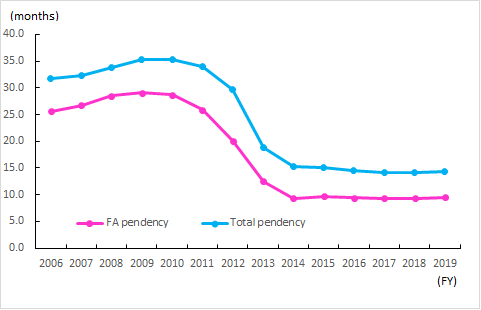
Figure: Total Pendency and FA Pendency for Patent Examinations
JPO Status Report 2020 Facts & Events 2019 (PDF:1,638KB)
[Last updated 19 October 2021]
|
Contact Us |
|
General Affairs Division, |